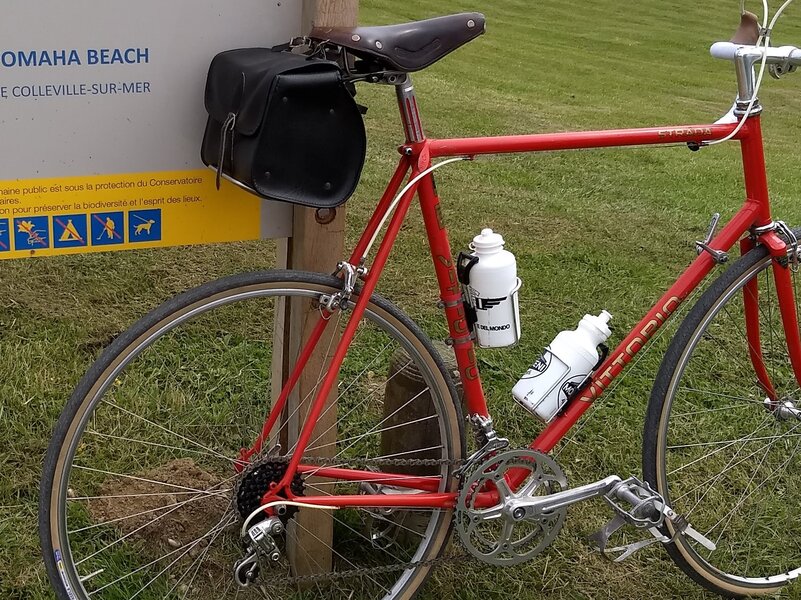You are using an out of date browser. It may not display this or other websites correctly.
You should upgrade or use an alternative browser.
You should upgrade or use an alternative browser.
Bob Jackson group set dilemma
- Thread starter EddieNplusOne
- Start date
EddieNplusOne
Retro Newbie
Thanks everyone for your great suggestions. I've narrowed down to mid to late 80s and pre-indexing (I think) as my preference is for friction shifting (I know crazy). That leaves Dura-Ace 7400, Ultegra 600 Tricolor, 105 Golden Arrow or Suntour Superbe-Pro although the Suntour is probably going to prove to be beyond budget. I spent today stripping everything down and rebuilding - adding some 105 brakes from the spares box so that I can at least ride the bike whilst searching for parts.
- Feedback
- View
Index that mofo, indexing has been around for 35 years for a reason!
EddieNplusOne
Retro Newbie
Progress update. I have gone with Golden Arrow although am holding back on the brakes at the moment mostly because the bike is intended as a half-day road bike rather than a period correct concourse entry! For this reason the current set-up is as follows (purists look away now): Shimano RX100 brake calipers and Dia Compe Gran Compe levers from the spares box. Good stopping power and comfort although front block fit requires some tinkering (upside down mounting). I swapped out the existing heavy wheels for some Miche hub/ Mavic rim road wheels that I also had in the spares box. New tyres but couldn't run to tan-wall on this occasion. Swapped out the Brooks B17 for a Brooks Swift (donated from another project bike) and chosen for weight. The gearing has been a challenge because I ride a lot in the Peak District so there is always climbing to be done. I set the bike up with 7 speed 11-28 and reduced the inner chain ring to give 52,38. 38 is the smallest that can be fitted as the crankset is 130 BCD 5 hole. According to the Shimano manual for the Golden Arrow derailleur I should be able to run up to a 28 on the back but this isn't really viable with the chain, sprocket and jockey wheel all touching when in this gear. For this reason I fitted a Keenso derailleur hanger which seems to have sorted out that problem. The alternative might have been to have found the long arm version of the Golden Arrow derailleur. The remaining issue is that when in the 38 chain ring and at the 11 tooth end of the cassette that the chain drags onto the bolt at the tail end of the front derailleur. Not really an issue because the 28 is there for the climbs and I'm surely then going to be looking towards to 28 tooth end of the cassette - nevertheless this indicates how fine the tolerances were back in the day and how little help was offered up too old'uns like me on the hills. Weight is 11.5 kg which is fine for a bike over 30 years old. I've ridden the bike almost 200 km on rollers and 40 km on roads so far so it's still bedding in but very pleased to have it.Just picked up a Bob Jackson road bike today. Frame number puts it at 1990 according to the handy chart posted by @FalconSS. Well maintained, already a fine ride but components are a real mix - the majority being Shimano 600 Arabesque (front & rear derailleurs and chaining/ cranks). Reading up about Arabesque these components must have pre-dated the frame by 10 years. The question is whether to complete the Arabesque group when replacing bog-standard brake levers and calipers or to start again with a group set from circa 1990 and in all probability get much better performance. Also stick with Shimano or look elsewhere?
Edit: The pedals are another concession to the modern age although the bearings on the Sakae SP-100s that were on the bike when I picked it up are as smooth as butter
Attachments
Last edited:
non-fixie
Senior Retro Guru
Similar threads
- Replies
- 7
- Views
- 585
- Replies
- 2
- Views
- 1K
- Replies
- 4
- Views
- 2K
- Replies
- 0
- Views
- 2K
- Replies
- 54
- Views
- 9K

